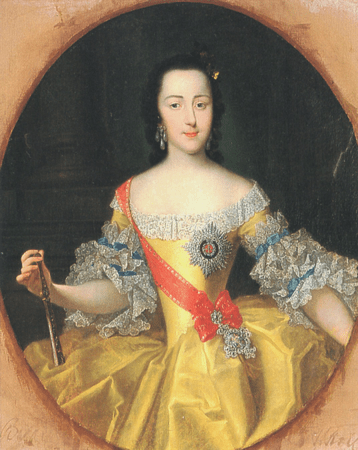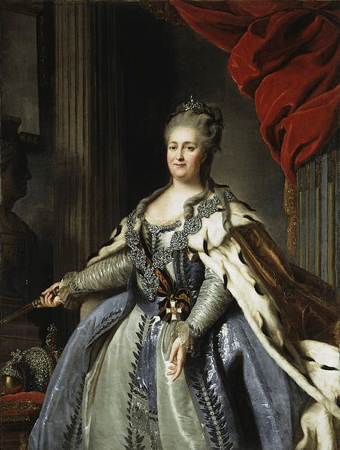Russia & Ukraine – Greek Diaspora History
Catherine the Great
Top 10 Facts About Catherine the Great
Catherine the Great, also known as Catherine II was an empress that championed the Greek diaspora in Russia and abroad. Empress of Russia between 1762 and 1796, Catherine the Great had a deep admiration for Greece and its history.
1. Catherine the Great wasn’t Russian
Catherine the Great was born in Stettin, in the Kingdom of Prussia (present day Szczecin, Poland). She was the eldest daughter of Prussian prince, Christian.
2. Catherine was not her birth name
Catherine the Great was born Princess Sophie von Anhalt-Zerbst. It was not until she converted to Russian Orthodoxy in order to marry Peter III, the heir to the Russian throne, that she was given the name Catherine.

3. Catherine the Great is regarded as one of the greatest rulers of Russia
Catherine the Great was not only the longest ruling female (34 years) in Russian history, but also regarded as one of the greatest – hence her title. Under her reign, Russia grew in strength and prosperity. The period of her rule is often referred to as the Catherinian Era and the Golden Age of the Russian Empire.
4. Catherine the Great gave 10 cities Greek names
During her reign, Catherine the Great gave the following major cities Greek names:
- Stavropol (1777), named after Stavropolis (meaning the City of the Cross).
- Kherson (1778), named after Chersonesus – an ancient Greek city in Crimea.
- Mariupol (1780), named after the Greek settlement of Mariampol, as well as the Russian Empress Maria Feodorovna.
- Nikopol (1782, renamed in 1786), named after Nike – the goddess of victory.
- Yevpatoria (1784), named after Eupator, which was a byname (meaning “of noble father”), often adopted by Hellenistic rulers, including Mithridates VI Eupator of Pontus.
- Simferopol (1784), named after Sympheropolis (meaning city of common good).
- Melitopol (1784, renamed in 1842), named after Melita (ancient port city) and the Greek word for Honey (meli).
- Nikolaev (1789), named after St. Nicholas, combining the Greek words for victory (nike) and people (laos).
- Tiraspol (1792, renamed in 1895), named after Tyras – the ancient Greek name for the Dniester River.
- Odessa (1795), named after the ancient Greek city of Odessos, thought to be located in the area.

5. Catherine the Great was very well educated
Catherine the Great adored philosophy, art, and history. She studied religion and history, as well as learning German, French, and Russian. With the aim of improving Russia’s education system, Catherine the Great wrote many books and other educational material. Seeing herself as an enlightened ruler, she struck up a friendship with one of the greatest philosophers of the time – Voltaire.
6. Catherine the Great was extremely ambitious
With her husband, Peter III, becoming largely unpopular shortly after ascending to the throne, a plan was hatched to place their son Paul on the throne, with Catherine the Great installed as Regent. Her ambitions however, were not to simply fade into the history books without having a profound influence on their development. Catherine the Great, with the help of her lover Gregory Orlov, claimed power and declared herself Catherine II, the sole ruler of Russia.
7. Catherine the Great had many lovers and they were rewarded generously
Catherine the Great is well known for her sexual promiscuity and she was famously loyal to her lovers. She bestowed them with titles, land, servants, and palaces.
8. Catherine the Great began building the Pella Palace
Unlike her son Paul, Catherine the Great was very close to her grandson Alexander, often referring to him as the new Alexander the Great. In 1784, she purchased an estate on the Neva River, 30km from Saint Petersburg and the following year named it after the birthplace of Alexander the Great – Pella. In 1785, construction began to replace the wooden manor on the estate with an imperial palace, recreating the palace of the ancient Greek palace of Macedon in the neoclassical style. If completed, the Pella palace would have become the largest Russian imperial palace. Unfortunately, the palace was only half built. Firstly, suspended during the Russo-Turkish War, and later demolished by Catherine the Great’s son and successor – Paul.

9. Catherine the Great wanted to restore the Byzantine Empire
Catherine the Great wanted to reclaim the lands lost by the Greeks and to resurrect the Byzantine Empire. She reconquered a number of historically Greek lands and put one of her grandchildren, coincidentally named Constantine, on the throne, but was never able to put her vision into fruition.
10. Catherine the Great set up a plan called the Greek Project
Like her predecessors, Catherine the Great sympathized with the Orthodox Christians under Ottoman rule. She sponsored the Orlov Revolt in Morea during the Russo-Turkish War of 1768–1774, and welcomed many Greeks to settle in Russia. The Greek Project, also known as the Greek Plan was masterminded by Prince Potemkin, who gave Greek names to the newly founded towns in New Russia (Novorossiya, which is in Ukraine). The aim was to partition the Ottoman Empire and restore the Byzantine Empire. Catherine the Great met with the Holy Roman Emperor – Joseph II and formed an alliance in her ambitions with Austrian monarchs. Unfortunately, after Joseph’s death in 1790, the agreement fell apart.

Do you have a connection to Greek Diaspora in Russia or Ukraine? Trace your ancestry to find out. There are a number of DNA tests available but the most common and most trusted of them all is Ancestry.com
